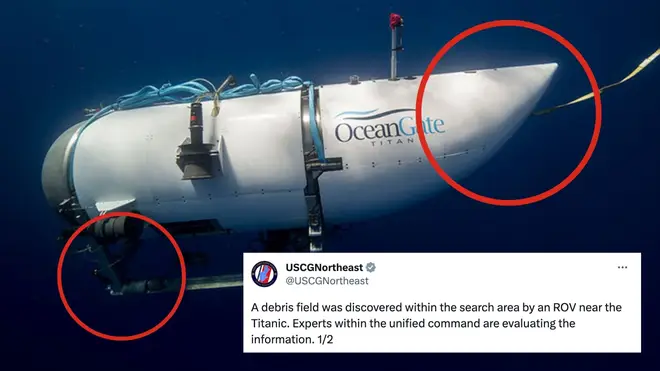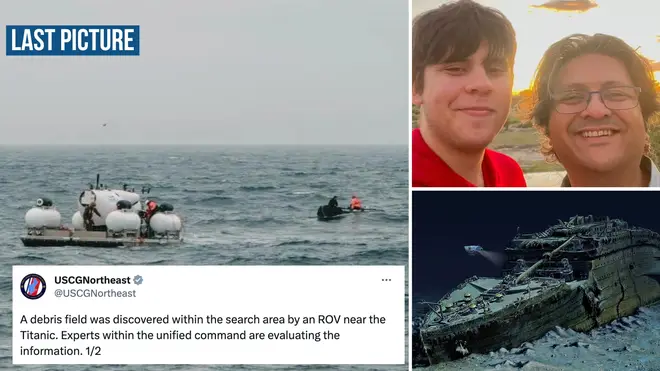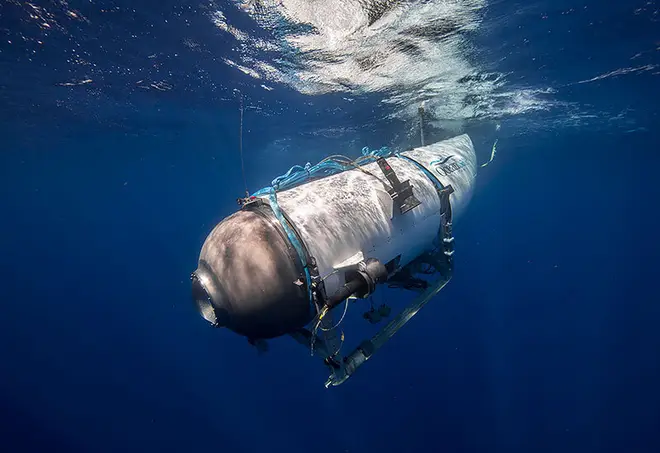
Oli Dugmore 4am - 7am
22 June 2023, 16:56 | Updated: 22 June 2023, 18:52

Experts leading the search effort for the missing OceanGate submersible have found a 'debris field' near the wreck of the Titanic.
The US Coast Guard says the debris is currently being "evaluated" by personnel at the command centre. An update is due at 8pm UK time from the Coast Guard.
Richard Garriott, President of the Explorers' Club said he had received WhatsApp messages stating that the debris found is its “landing frame” and “rear cover.”
He said that the debris field implies a “break up of the submersible at depth… a catastrophic failure, an implosion.
“The only saving grace is that it would have been immediate, literally in milliseconds and the men would have no idea what was happening,” said David Mearns, a friend of the two men on board.

Earlier the head of the search operation for the missing Titan submersible has said that it is still an active "search and rescue" mission.
Rear Admiral John Mauger said: "We continue to keep the crew members and families in our thoughts."
But he insisted this is "still an active search and rescue right now", and added: "Conditions for the search and rescue are favourable right now."

Ships, planes and underwater craft from multiple countries have been deployed to the area with rescuers searching a remote part of the Atlantic Ocean more than twice the size of the US state of Connecticut in waters as deep as 4,020m (13,200ft).
Currently there are two ROVs (remote operated vehicles) capable of operating on the sea floor. Both have cameras and sonar capability.
A deep water robot sub has reached the Atlantic floor - and another is descending the 12,500ft of ocean fast.
"The Canadian vessel Horizon Arctic has deployed an ROV that has reached the sea floor and began its search for the missing sub", a spokesman said.

And a French ship viewed as the best and final hope of finding the missing Titanic submersible has also dropped its remote-controlled sub to find five missing adventurers.
L'Atalante arrived on the scene at 11.48am GMT (7.48ET) and has deployed Victor 6000, which can reach depths of 20,000ft and will arrive at the Titanic's wreck in the next two hours.
Victor 6000 has arms that can cut cables - or dislodge a trapped or stranded vessel - and may be able to fix a cable onto the sub before it is hauled several miles to the surface by a giant winch with more than three miles of cable called a Flyaway Deep Ocean Salvage System on Horizon Arctic.

The submersible Titan, which was taking five passengers down to see the wreck of the famous passenger liner, vanished earlier this week and it was estimated to have 96 hours of oxygen.
It disappeared while venturing to the ship on Sunday, which is 400 miles off the coast of Newfoundland, in the Atlantic, and some 12,000ft below the surface.
The submersible Titan, which was taking five passengers down to see the wreck of the famous passenger liner, vanished earlier this week and it was estimated to have 96 hours of oxygen.

United States Coast Guard make statement about ongoing search for Titan
It disappeared while venturing to the ship on Sunday, which is 400 miles off the coast of Newfoundland, in the Atlantic, and some 12,000ft below the surface.
British billionaire Hamish Harding is aboard, as are Paul-Henri Nargeolet, a French explorer, Shahzada Dawood, a UK-based Pakistani businessman who is a board member of the Prince's Trust charity, his 19-year-old son Suleman Dawood, and Stockton Rush, the CEO of OceanGate.
It is hoped they will have tried to relax and conserve energy so as not to waste precious supplies of oxygen.Guillermo Sohnlein, who founded OceanGate with Mr Rush in 2009, said they could live past the Coast Guard's estimates of oxygen supply.
"Today will be a critical day in this search and rescue mission, as the sub's life support supplies are starting to run low," he said.
"I'm certain that Stockton and the rest of the crew realised days ago that the best thing they can do to ensure their rescue is to extend the limits of those supplies by relaxing as much as possible.
I firmly believe that the time window available for their rescue is longer than what most people think. I continue to hold out hope for my friend and the rest of the crew."
As oxygen levels in the 6.7 metre long vessel fall, more carbon dioxide will be in the atmosphere because the five passengers have been exhaling.
Carbon dioxide poisoning can cause asphyxiation or hypercania, a condition where too much gas is in the bloodstream.
Dr Ken Ledez, a hyperbaric medicine expert at Memorial University in St John's, Newfoundland, said: "As levels of carbon dioxide build up, then it becomes sedative, it becomes like an anaesthetic gas, and you will go to sleep."
Once the level of carbon dioxide in someone's blood is higher than 10%, they are likely to die quickly.
People can live for about 15 minutes without oxygen, though they lose consciousness long before then.They are likely to suffer brain damage after just a few minutes without air.If the sub is very deep down, the temperatures could be extremely cold.
But this could be an advantage, Dr Ledez said."There is a possibility if they cool down enough and lose consciousness they could live through it - rescuers know this," Dr Ledez he told the BBC.
The rescue operation has not been called off.
A French ship, L'Atalante, has used the Victor 6000, a robot sub that can go as low as 20,000ft.
It has arms that could attach a cable to the sub that could bring it back to the surface.
But it has not even been located yet. Hopes that banging noises could lead rescuers to the vessel have not led to any results.